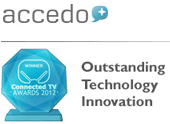 By: Michael Lantz, CEO, Accedo Broadband
By: Michael Lantz, CEO, Accedo Broadband
Second screen applications are not about copying the remote
Applications running on a mobile device, controlling the TV experience have been all the rage in 2012. With the growth of powerful mobile devices, it seems logical that consumers will want to use these new devices to control the TV. Everyone agrees that most TV remotes of today are clunky and not very modern. As a result, all TV manufacturers now offer a mobile application that can be downloaded from various app stores and used to control the TV. The user interface provides a more attractive touch interface and can offer multi-page navigation between remote control features and settings menus. However, with a few exceptions, these applications have not offered anything new to consumers, and success has been very limited. At the end of the day, it’s still faster and more convenient to switch channels on the old ugly remote than on the mobile.
Information-centric and social applications provide the next steps
We have also seen the emergence of a plethora of applications from start-ups and larger companies that offer enhanced information about TV content. In addition to a traditional program guide with metadata and information about programs, they normally offer integrations with various Internet services ranging from online video services like YouTube to social networks like Facebook. I’m very excited about this trend, which I think will be a great complement to TV services in the future. It seems logical that the brands we all know in the TV industry will dominate this space on most markets, and the TV operators should be able to, with their knowledge of the consumer and the TV distribution, be able to create a superior experience to all start-ups on the market. Innovation will remain high over the coming years.
An integrated experience provides highest consumer value
Personally, I think that the largest opportunity from a consumer point of view to provide the second screen experience at the time consumers require it. For example, it seems natural that a user of a catch-up TV service from a major TV channel on a tablet in the living room next to his TV, would like to browse and search content on that tablet, but play it on the big TV screen. Similarly, if a user watches live content from that broadcaster, they will get exposed to program-specific additional content if they start the catch-up TV application from the broadcaster. Of course, there are some technical hurdles to solve this problem, including multi-device to multi-device pairing and place shifting of DRM-protected content, but powerful solutions like Accedo Connect exist on the market to solve this problem.
The TV experience will not go away, but will evolve
I get many questions from customers whether traditional TV will be threatened by the second screen trend. My observation is that the popularity of TV has never been higher and people spend more and more time with their TV experience. Of course, the TV experience will evolve over the coming 5-10 years dramatically, and everyone who wants to stay relevant needs to innovate with this industry trend. It is also clear that increasingly TV viewing will shift from live to on demand and with added viewing on mobile devices. But it is equally clear that video content is best experienced on the big screen and this screen will continue to dominate the revenues and the hours spent on content consumption in the future.

